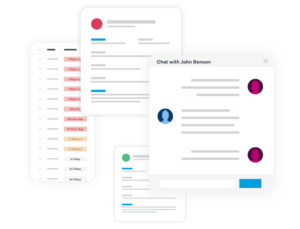How Technology Is Forging the Future of Sales
As technology advances, customers have shifted how they make decisions. At the click of a mouse, consumers can get a full 360-degree review on a service or product they desire, browsing competitors, company reviews, and markets—all at record speed. Companies have had to pivot away from the assumed.
Organizations trying to drive their sales strategies by looking in the rear-view mirror of customer insights quickly found themselves outmatched by competitors with forward-looking sales strategies. Now more than ever, companies need the power of data insights and predictive analytics to navigate the new normal.
The pandemic put the kibosh on in-person sales meetings and fueled a rise in the adoption of digital channels for sales interactions. Research by Mckinsey has found that more than three-quarters of buyers and sellers say they now prefer digital self-serve and remote human engagement over face-to-face interactions. This sentiment has steadily intensified even after lockdowns have ended.
As a result, companies can no longer rely on old ways to influence their prospects, forcing them to be more creative. This leveled the playing field for vendors of all sizes. Sales teams have found themselves working harder to win hearts and minds. Sales is now a serious cross-business function, driven by technology, data, and innovation.

Here’s what you need to know to ensure your organization stays ahead.
The Buyer Lifecycle
All data across the entire buyer lifecycle can now be captured and analyzed, presenting an exciting opportunity for sales organizations. Their analysis can help companies triangulate the specific marketing and sales efforts that contributed to any deal closing—across the full range of web clicks, downloads, phone calls, emails, SMS messages, or chat interactions. You can cross-correlate those activities with buyer roles, account demographics, specific needs, pricing, and promotions.
To capitalize on this opportunity, organizations must have the means to collect and analyze this ‘sales digital exhaust’ to optimize future sales efforts by tapping into the power of machine learning and predictive analytics capabilities.
Sellers now need to ‘read the room’ virtually. So, reading body language becomes far more complicated, and listening skills become crucial to understanding the tone of the conversation. The act of pausing to engage is a critical skill.
Challenge and Consult
The pandemic has been ‘the great leveler’ in the sales world, where high-profile in-person events and wining and dining were previously the norm. Now in the post-pandemic era, where we’ve removed the influence of the ‘boozy lunch,’ there’s more pressure on sellers to sell more on merit and value rather than generosity.
The need to move away from a transactional sales relationship to one of sales consultancy was recognized in the ‘70s and ‘80s. We’ve now moved onto the ‘challenger sale’ where we challenge the buyer and provide additional value. There is an expectation from existing and potential customers to be challenged by their vendors. Today, customers are not afraid to ask difficult questions to ensure that they make the right choice.
The other vendors’ responsibility is to challenge marketers to widen their lens to the entire customer journey and talk to their sales and service counterparts. So even if you’re selling into just three distinct buying groups, you must find ways to connect them and bridge the critical gaps that often get missed among sales, marketing, and customer service.
Let the Platform Do the Work
Sales is a full-contact sport—it typically requires internal resources to get from lead to revenue, and obviously, it requires customers, prospects, and sometimes partners. Technology plays a massive role in the ‘new world’ of selling, providing meaningful insights across the entire customer journey. Aggregating information from key touch points via email and other third-party sources is paramount to creating a holistic view of who your customer or prospect is.
However, the technology supposed to empower sales professionals can be a barrier to their success. Sugar’s global research among sales leaders found that businesses struggle to ensure sales teams spend enough time with customers and can access the data required to build and maintain these vital relationships. 52% of the respondents say their reliance on legacy CRM costs them revenue.
Technology must rescue sales from the intense manual labor of entering data into the system and yet make more data readily available to the sales rep to help them make better, faster decisions that result in revenue growth.

AI and machine learning can help analyze an organization’s lead prioritization, opportunity-to-close-won scoring, and Ideal Customer Profile alignment. This enables them to understand which businesses are similar to other businesses in their customer base and the attributes that make these customers the best and most profitable. These insights and understanding enable salespeople to focus their prospecting on those companies that are the best fit and represent the greatest chance of purchase and profit.
Another emergence we have seen is the live virtual deal room, where buyers and sellers interact in real-time. The time lag of collaborative back and forth negotiating is removed, so buyers and sellers can get to an outcome far more quickly than with traditional sales cycles. The sales process’s new immediacy and dynamism demand sellers access as much information as possible to support smart and savvy negotiations in real-time.

Optimizing your Sales Strategy
Top sellers seek to understand the problem they are solving through a multi-channel approach. They use telephone, chat, and video conferencing to build a relationship with the prospect or customer. Top sellers record their calls, share them with their teams, capture all interaction points, and constantly look for ways to improve. AI can help paint a picture of what channel to use when and what next action to take.
The most valuable thing for a salesperson is time, so giving their time back in this way is critical. No salesperson wants to be anchored to a keyboard like a trained monkey. To be top sellers, organizations need to free their people to spend as much time weaving the magic of selling.
Despite technology’s role in optimizing the sales equation, sales will always be a relationship-driven art and science. Top sales organizations recognize this and enable their salespeople to shine by letting their sales automation platforms do the work to eliminate blind spots, busy work, and roadblocks.
This article was initially published on B2B Marketing.



